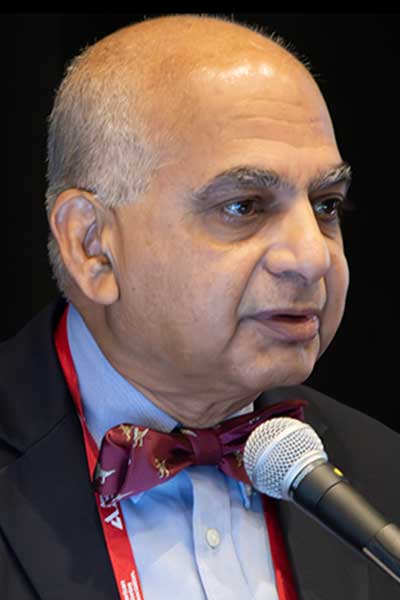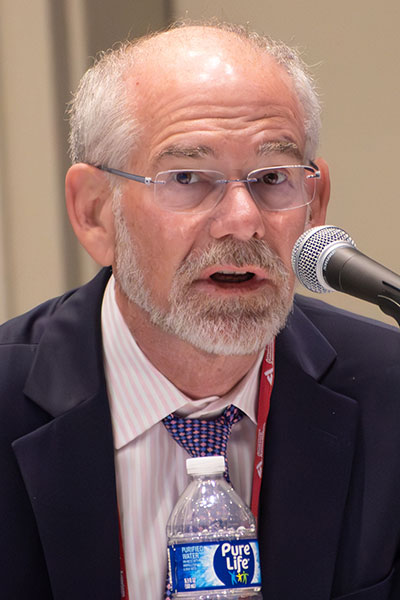Hypercortisolism has emerged as a common and largely unrecognized contributor to type 2 diabetes that is difficult to manage despite multiple medications. The CATALYST trial of mifepristone in individuals living with difficult-to-treat type 2 diabetes reduced A1C by 1.32% versus placebo. The A1C reductions came despite diabetes medication dose reductions in half the mifepristone participants during the 24-week trial.

“There was a discontinuation of some [diabetes medications], especially fast-acting insulin and sulfonylureas, and reductions in dose of long-acting insulin,” said Vivian Fonseca, MD, Professor of Medicine and Pharmacology, Chief of the Section of Endocrinology, and Assistant Dean for Clinical Research at Tulane University School of Medicine. “This is a more precise way of treating diabetes than giving any drug that comes along,” he continued. “You identify an abnormality and treat that abnormality.”
Dr. Fonseca delivered the findings during Treatment of Hypercortisolism in People with Difficult-to-Control Type 2 Diabetes—Final Results of the CATALYST Trial on Monday afternoon, June 23, at the 85th Scientific Sessions. CATALYST data suggest hypercortisolism contributes to difficult-to-treat type 2 diabetes in at least 1.125 million people in the U.S. alone. The U.S. Food and Drug Administration (FDA) has approved mifepristone to treat hyperglycemia secondary to hypercortisolism in adults with Cushing syndrome and living with type 2 diabetes or glucose intolerance.

Hyperglycemia secondary to hypercortisolism is a commonly missed diagnosis of difficult-to-treat type 2 diabetes, explained Ralph A. DeFronzo, MD, Professor of Medicine, Chief of the Diabetes Division, and Deputy Director of the Texas Diabetes Institute, University of Texas Health Science Center at San Antonio. Few individuals with hypercortisolism present with the classic phenotypic features of Cushing syndrome.
“The kind of patients I see with Cushing syndrome have difficult-to-control type 2 diabetes, hypertension, visceral obesity, and osteoporosis or fractures,” he said. “Until recently, we really haven’t started to look for this.”
International data suggest that about a quarter of people living with difficult-to-treat type 2 diabetes, despite multiple antidiabetic agents, have hypercortisolism, he continued. CATALYST screened 1,057 people living with difficult-to-treat type 2 diabetes with an A1C of 7.5%–11.5%. All were on multiple anti-hyperglycemic or hyperglycemic and antihypertensive agents. Screening was an overnight 1 mg dexamethasone suppression test with a 1.8 μg/dl cortisol cut point.

A total of 23.8% participants tested positive for hypercortisolism, in line with international numbers. A total of 91 patients were randomized to mifepristone and 45 to placebo.
“This is the largest prospective study to date of hypercortisolism in difficult-to-treat diabetes and pharmacologic treatment of hypercortisolism,” said Vanita R. Aroda, MD, Director of Diabetes Clinical Research at Brigham and Women’s Hospital and Associate Professor of Medicine at Harvard Medical School.
Patients received a starting dose of mifepristone of 300 mg daily, increasing to 600 mg daily. Mifepristone could be increased to 900 mg daily at the investigator’s discretion.
In addition to the 1.32% A1C reduction, individuals taking mifepristone lost 5.1 kg compared to placebo, 5.1 cm in waist circumference, and 1.7 kg/m2 in body mass index (BMI), Dr. Fonseca reported.

Treatment-emergent adverse events were common, but most were mild to moderate, consistent with mifepristone’s known safety profile. The mifepristone discontinuation rate was 28.6%, due largely to the expected glucocorticoid withdrawal symptoms. Withdrawal symptoms can be managed in clinical practice, Dr. Fonseca noted, but not in the double-blind trial.
“Screening was easy to perform,” added John B. Buse, MD, PhD, the Verne S. Caviness Distinguished Professor of Medicine, Director of the Diabetes Care Center, and Director of the Translational and Clinical Sciences Institute at the University of North Carolina at Chapel Hill. “We should screen for hypercortisolism in patients whose type 2 diabetes is challenging to treat. Identifying and addressing hypercortisolism is a novel path to improving diabetes care in people worldwide.”
The results of the trial were published in Diabetes Care® concurrent with the symposium.
On-demand access to recorded presentations from this session will be available to registered participants of the 85th Scientific Sessions through August 25.

Watch the Scientific Sessions On-Demand after the Meeting
Extend your learning on the latest advances in diabetes research, prevention, and care after the 85th Scientific Sessions conclude. From June 25–August 25, registered participants will have on-demand access to presentations recorded in Chicago via the meeting website.

